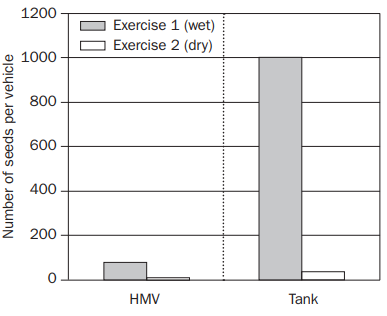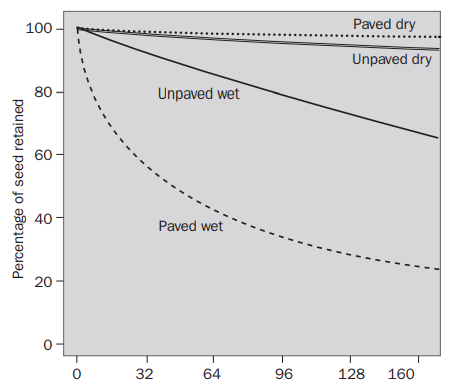
Weed Seed Dispersal by Vehicles
Field studies showed vehicles pick up and disperse seeds. ATVs picked up and carried more seeds off-trail than on-trail, with higher numbers in the fall than spring. Other vehicle types picked up more seeds when driven on wet than dry unpaved roads. Seeds fell off vehicles more rapidly under wet conditions, while few seeds fell off under dry conditions.
Last Updated: 04/17by Kimberley Taylor, Graduate Research Assistant; Jane Mangold, MSU Extension Noxious Weed Specialist; and Lisa J. Rew, Assistant Professor, Department of Land Resources and Environmental Sciences
INVASIVE WEED SPECIES CAN BE PROBLEMATIC
and costly to control. It is more cost effective to prevent new invasions and eradicate small patches, than to spend money trying to control or eradicate large existing patches. Therefore, it is necessary to understand how weeds spread in order to prevent new invasions.
The abundance of weeds along many roads suggests that vehicles may be acting as dispersal vectors. In fact, studies have found that passenger vehicles can carry anywhere from three to 135 seeds per vehicle. Vehicles have managed to spread over 500 different plant species. Vehicles are most likely picking up seeds from the road or roadside and then spreading them farther along the road. If vehicles transport seeds long distances, they may carry weed seed to areas where they do not yet occur. Once growing along roadsides, other types of dispersal may move the weeds farther into the surrounding area.
The pervasiveness of roads means that vehicles could be a major mode of plant dispersal. In fact, a study done in Chile showed that an increase of roads in an area led to an increase in weed species. There are 4 million miles of roads in the U.S. that are split almost evenly between paved and unpaved surfaces. Eighty percent of the roads are rural and occur in all types of environments, reaching relatively remote and weed-free areas. Outdoor recreationists who travel on remote roads to trailheads or who ride ATVs off roads or designated trails may be unknowingly spreading weeds with their vehicles.
Work at Montana State University measured the number of seeds picked up by vehicles and the distance seeds traveled on vehicles before they fell off. Different types of vehicles (trucks, ATVs, tracked vehicles), road surfaces (paved, unpaved, trails, off trails) and moisture conditions (wet and dry) were studied to determine how they affected seed dispersal. Understanding how many and how far seeds are transported by vehicles under different conditions will help direct prevention activities (wash stations, road closures, education, etc.) to reduce weed seed dispersal along trails and roads.

FIGURE 1. Washing an ATV to collect soil/seed material.
Field Study
Three field studies determined if vehicles act as seed dispersers by quantifying the number of seeds gained and lost by vehicles over distance. The first study determined how many seeds ATVs pick up driving on- and off-trail in the Gallatin National Forest, Montana, during spring and fall. Clean ATVs were driven for 16 miles either on- or off-trail and then washed to collect seed material (Figure 1). This process was repeated so that ATVs were driven a total of 144 miles both on- and off-trail in late spring and in fall. The soil containing seeds was collected, grown in a greenhouse and identified. The total number of seeds and species were quantified from the seedlings that emerged from the collected soil material. The off-trail test area was mostly smooth brome, with a couple patches of Canada thistle and a small amount of spotted knapweed.


A B
FIGURE 2. Plates containing mud/seed mixture attached to the front bumper (A) and to a wheel well and underside (B), highlighted by arrows.
A similar study was conducted at two National Guard training areas in Montana and Idaho. Vehicles (Humvees, trucks, ATVs and tanks) were washed at the beginning and end of spring training exercises at one of the sites for three successive years. Soil material from vehicle washes after the exercises was collected and planted as described above. The distance vehicles traveled during the exercises was recorded with a GPS (global positioning system) unit placed on each vehicle. This process made it possible to determine the number of seeds picked up per vehicle per mile. It rained during one set of exercises enabling comparison between the number of seeds picked up by vehicles under wet and dry conditions.
The final field study determined how long seeds stay attached to vehicles before they are dispersed. Plates containing mud and a known number of seeds (non- weedy) were attached to the bumpers, undersides and wheel wells of a pickup truck (Figure 2). The truck was driven on both paved and unpaved roads, under both wet and dry conditions. The truck was driven a total of 160 miles under each combination of road type and road condition (e.g. wet paved road, dry paved road, wet unpaved road, dry unpaved road) at set speeds. Plates were removed at seven distances to better understand the effect of distance, road surface and road condition on seed retention. Soil remaining on each plate after driving was scraped off, sieved and any retained seeds were counted.
Results
ATVs collected a large number of seeds in both seasons on- and off-trail (Figure 3). More seeds were collected in fall than spring, likely due to seed availability. However, the percent of exotic to total seeds was higher in the spring (98 percent exotic) than the fall (59 percent) likely because natives tend to set seed later than exotics in this environment (Figure 3). The total number of seeds collected was greater off-trail than on-trail, but large numbers of seed were still collected on-trail (21 seeds/mile in spring and 394 seeds/mile in fall). The off-trail site was particularly rich in seed material, which could explain the large quantities of seed picked up driving in this area.
The study at the military sites determined that many more seeds were collected by vehicles driven under wet conditions than under dry conditions (Figure 4). For Humvees, 14 times more seeds were picked up when it was wet than when it was dry. The difference was even greater for tanks which picked up 26 times more seeds when it was wet compared to when it was dry. (While not tested in this study, bulldozers and other tracked construction vehicles will likely pick up seeds at a similar rate.) Under dry conditions tracked vehicles still collected more seeds than wheeled vehicles, but the number of seeds picked up by different types of wheeled vehicles did not vary significantly (i.e. ATVs, Humvees and six to 10 wheel trucks all collected similar numbers of seeds). All types of vehicles collected seeds from a large number of different species that included a wide variety of seed types, shapes and sizes.

FIGURE 3. The number of seeds/mile collected by ATVs increased greatly when the vehicle was driven off-trail; however, large numbers of seeds/mile were collected even on trails, especially in fall. A large proportion of seeds collected in both seasons were exotic.

FIGURE 4. Many more seeds were collected by both Humvees (HMV) and tanks in wet than dry conditions when vehicles were driven similar distances on the same roads.
The seed loss study found that most seeds (99 percent on paved and 96 percent on unpaved) stayed attached to the vehicle after travelling 160 miles under dry conditions (Figure 5). However, retention was lower (86 percent) on the wheel well plates on the unpaved dry roads, likely due to the gravel thrown at the plates by the wheels. Under wet conditions there was much lower seed retention on both paved and unpaved roads. Wheel well plates retained zero and undersides only 37 percent of seeds after travelling 80 miles on paved wet roads. Whereas, on unpaved wet roads, wheel well plates retained 50 percent and undersides 60 percent of the seeds after 160 miles. The patterns of seed loss differed on front and rear bumper plates for both paved and unpaved roads under wet conditions. Wheel well plates lost more seeds than plates at all other locations. Seeds of different sizes and shapes were lost at the same rate.
Conclusion
Our results show that vehicles can pick up large numbers of seeds, especially when driven off-trail, and under wet conditions. But, even when staying on roads and trails, vehicles still collect seeds. If seeds are picked up in mud which then dries on the vehicle, they can travel almost indefinitely until it rains or the road surface is wet, allowing for long distance transport of seeds. This transport may result in deposition of seeds in areas where those species did not previously exist. To help prevent the spread of weeds, washing vehicles frequently would be beneficial, especially before and after driving on roads with high densities of weeds along the edges or after driving off-road or trail. In areas where high risk invasive species are present, particularly along unpaved roads, it would be wise to close the area when conditions are wet because the risk of picking up weed seeds and transporting them is greatly elevated under such conditions.
Acknowledgements
We would like to thank the personnel at the Fort Harrison National Guard Base in Helena, Montana for all of their assistance with the field trials at that site and at Orchard Training Area in Boise, Idaho, and the personnel at OTA for allowing us on site; and Little Red Hen LLC staff for their assistance throughout the military washing trials. This part of our study was funded by Strategic Environmental Research and Development Program (SERDP) project RC-1545. The ATV study was funded by a Montana Noxious Weed Trust Fund Grant (2008-005) and we would like to thank the staff of Sweetgrass County for their assistance with the ATV washes, and John Councilman and the Gallatin National Forest for their site assistance.
More detail about these studies can be found on http://weedeco.msu.montana.edu.

FIGURE 5. The percentage of seeds remaining on the vehicle with distance on different roads surfaces and moisture conditions. Most seeds are lost under wet conditions.

